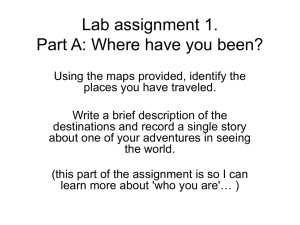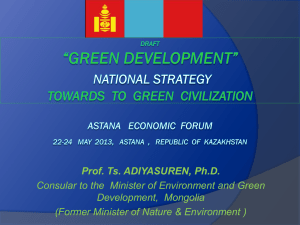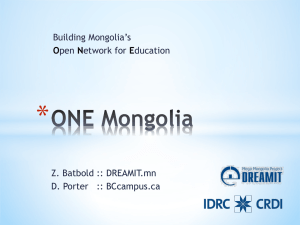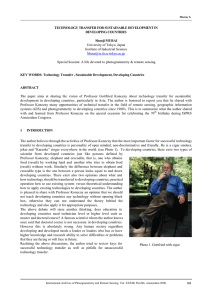Report
advertisement
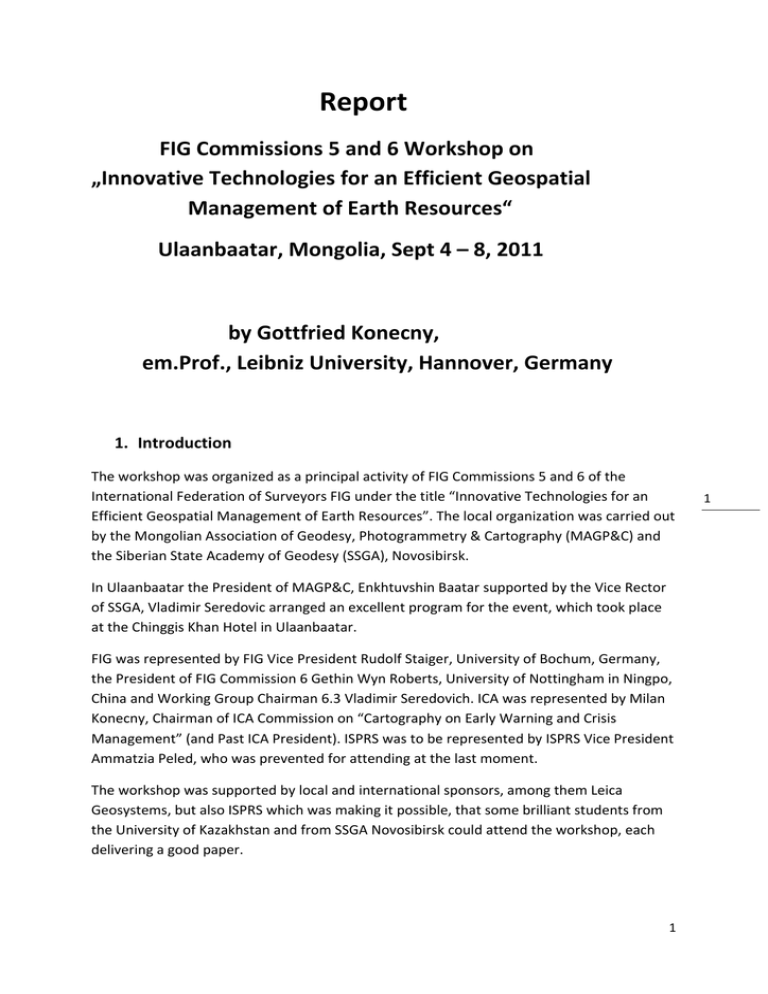
Report FIG Commissions 5 and 6 Workshop on „Innovative Technologies for an Efficient Geospatial Management of Earth Resources“ Ulaanbaatar, Mongolia, Sept 4 – 8, 2011 by Gottfried Konecny, em.Prof., Leibniz University, Hannover, Germany 1. Introduction The workshop was organized as a principal activity of FIG Commissions 5 and 6 of the International Federation of Surveyors FIG under the title “Innovative Technologies for an Efficient Geospatial Management of Earth Resources”. The local organization was carried out by the Mongolian Association of Geodesy, Photogrammetry & Cartography (MAGP&C) and the Siberian State Academy of Geodesy (SSGA), Novosibirsk. In Ulaanbaatar the President of MAGP&C, Enkhtuvshin Baatar supported by the Vice Rector of SSGA, Vladimir Seredovic arranged an excellent program for the event, which took place at the Chinggis Khan Hotel in Ulaanbaatar. FIG was represented by FIG Vice President Rudolf Staiger, University of Bochum, Germany, the President of FIG Commission 6 Gethin Wyn Roberts, University of Nottingham in Ningpo, China and Working Group Chairman 6.3 Vladimir Seredovich. ICA was represented by Milan Konecny, Chairman of ICA Commission on “Cartography on Early Warning and Crisis Management” (and Past ICA President). ISPRS was to be represented by ISPRS Vice President Ammatzia Peled, who was prevented for attending at the last moment. The workshop was supported by local and international sponsors, among them Leica Geosystems, but also ISPRS which was making it possible, that some brilliant students from the University of Kazakhstan and from SSGA Novosibirsk could attend the workshop, each delivering a good paper. 1 1 2. Initial Excursion, Sept 4, 2011 The Workshop began with a one day excursion to the Gorkhi-Terelj National Park, about 60km north-east of Ulaanbaatar. The particiapants not only got to know each other, but they also obtained an excellent impression of the vast Mongolian landscape, its population and its pasture animals. There was also the opportunity to climb to a Buddhist monastery and to eat local food in a yurt. 2 2 3. Opening of the Workshop, Sept 5, 2011 The Workshop was officially opened by Enktuvshin Baatar. Opening Statements were made by Rudolf Staiger (FIG), local dignitaries, Vladimir Seredovic, Ivo Milev, Berlin (FIG Commission 6), Kaisar Khazenov ( Kazakhstan State Technical University). Yuri Raizman (Visionmap, Israel) addressed the meeting on behalf of Ammatzia Peled, ISPRS. Milan Konecny (ICA) followed. 3 4. Technical Sessions, Sept 5, 2011 Enktuvishin Baatar, MAGP&C outlined the aims of the Mongolian Association of Geodesy, Photogrammetry and Cartography. Milan Konecny, ICA summarized the international efforts in geospatial activities for disaster management, making reference to GMES, Inspire and GEOSS. Rudolf Staiger, FIG demonstrated, that Microsoft Excel can be used for Least Squares Adjustment. 3 Gottfried Konecny, Leibniz U. Hannover spoke on the innovation forces in geoinformatics technology: - GNSS-GPS developments Digital cameras The increasing number and quality of satellites as remote sensing platforms Laser technology Computer developments still expanding at exponential rates (Moore´s Law) Data base and GIS technology The Internet Mobile technology Vladimir Seredovich, SSGA described the state of the art of terrestrial laser scanning with many engineering applications. Kaisar Khazenov, Kazakhstan reported on the positive experiences of the FIG Workshop 2010 on Innovative Technologies in Ust-Kamenogorsk, East Kazakhstan. D. Amarsaikhan, Mongolian Academy of Sciences presented a number of case studies for the application of remote sensing in Mongolia. 1) the study of urban land cover using Quickbird images in Ulaanbaator and knowledge based classification based in Brovey transforms 4 2) the use of polarimetric SAR (ALOS) for the Chenggis Khan airport area 3) urban land cover studies combining TerraSAR X and Quickbird images 4) the use of ground penetration radar around pumping wells of Ulaanbaatar 5) the use of Hyperion in hyperspectral remote sensing for land cover. Saandari Mijiddorj, Monmap, Mongolia discussed their project for urban mapping and the cadastre for 11 major city sites, in which the fenced in cadastral “Hasha”plots were mapped, using orthorectified satellite images of World View 2. Boris Ivlev, Foundation for Venture Investments, Novosibirsk Region presented possibilities to bridge the gap between University theory and practical application. The Novosibirsk Oblast has spent 400M Rubles for this type of technology transfer. Vincent Lui, Leica Geosystems, Hongkong explained the relation and the supplementing technologies between Hexagon, which owns Novatel, Intergraph, Leica Geosystems and Brown & Sharpe. In Mongolia Monmap is the Leica agent. 4 Yuri Raizman, Visionmap, Israel described their efficient A3 Camera System. Sergey Kadnichansky, Meridian, Moscow reported on the activities of Meridian, which has about 2000 employees engaged in mapping. The company operates 3 types of digital cameras: the Z/I DMC, the Leica ADS40 and the Visionmap A3. Each type has different advantages. For mapping scales 1:10 000 and 1:25 000 the DMC, the ADS40 and the A3 do not need ground control when operated with GNSS and IMU (except for checks). The ADS40 has the advantage of using different b/h ratio stereo options. Eugene Levin, Michigan Tech demonstrated the ergonomic capabilities offered by neurological research Ms. Munkhtsetseg Dalkhaa, Administration of Land Affairs, Construction, Geodesy and Cartography spoke on Mongolia´s geodetic network, its renewal as well as national mapping for topography and the cadastre. The head office has a staff of 140. WGS84 is now used as a reference and a geoid model has been developed. Legislation has been passed on land; geodesy and cartography; land privatization; cadastral mapping and the land register. A law on NSDI is in process. There are about 100 private survey companies in Mongolia. 3 to 4 of these have aerial mapping capabilities and 5 to 7 for photogrammetric data extraction. The geodetic reference is the Monref 97 network, which has been densified by GNSS. 5 The leveling network od the 1940´s has been remeasured from 1970 to 1990, and a new releveling will take place from 2011 to 2017. The geoid model is accurate to 15 to 20cm. Geodetic transformation between GNSS and local network points is now possible to 20cm. 5. Technical Sessions, Sept 6, 2011 Ivo Milev, Technet, Berlin, Germany presented his involvement in the German Railway Infrastructure Maintenance Program, based on mobile GNSS operations. It uses the Eupos GNSS Service for Europe, which integrates various national high density networks. The database for the railway infrastructure is “Oracle DB” with web application using Google images and property layers. Gethin Wyn Roberts, University of Nottingham in Ningpo, China has within FIG a special interest in monitoring bridges. He showed examples of the Millennium Bridge, London, the Humber Bridge, Firth of Forth and the Severn Bridge. On these spectral analysis of the frequencies measuered on cables is made. 5 Victor Adrov, President of Racurs, Moscow spoke about Photomod, which has continuously evolved since 1993. As a photogrammetric system it includes block formation, automatic aerial triangulation, DTM and orthophoto generation as well as mosaicking. It is used by 510 companies world wide, in part with distributed processing capabilities. Enkhtuya Sodnom, Topsurvey, Mongolia analyzed the height systems in Mongolia since 1940 The releveling revealed height changes of up to 70cm in local areas due to crustal movements. Munkhzul Bandikhuu, ASME-MON LLC, Mongolia described the Mongolian efforts for regional and local coverage of the geoid based on the global geoid model EGM96. Janna Drannikova, East Kazakhstan State Technical University discussed use and transformation of measurements in false coordinate systems Aleksandr Chermoahentsev, SSGA discussed the automatic generation of 3D building models using a decision tree classification and the vectorization of points of equal heights. Alexandre Carayon, EADS – Astrium, Beijing: Astrium, owned by EADS, is a merger between Spot Image and Infoterra. He reported on Astrium´s classical approaches (true orthophoto, DTM, vector mapping) and the new “Pixel Factory” software applications. Spot 5 was able to cover Iraq with images in 4 months. From these images map updates are possible at the scales 1:50 000 and 1:100 000. Even topo mapping at 1:25 000 is possible. Urban areas need higher resolution than 2.5m GSD for mapping at the scale 1:5000; for this purpose Pleiades will be launched for use after 2011. 6 Stereo mapping is now possible using the Spot5 HRS instrument for the generation of DSM´s at 20m grid spacing. So far 1.4M square km have been covered by HRS. A typical project was the 1:50 000 mapping of Western China . Alia Kanapyanova, East Kazakhstan Technical University paid tribute to the Kazakh geodesist Muhambet Mashimov. Gottfried Konecny, Leibniz University Hannover made a poster presentation on the Establishment of Effective Land Registration and Cadastral Systems Eugene Levin, Michigan Tech made comments on the global aspects of education for the global workforce: - What are industry demands E-learning Graduate degrees International cooperation Ongoing research 6 He concluded, that Russian educational programs at Moscow and Novosibirsk met the industrial demands with a strong research component. In the USA this is not so within the B.Sc programs. Therefore this must be done within the graduate programs, which are interdisciplinary and flexible. In demand are fundamental courses, not “buttonology”. There is of course a problem with resources of staff, so that Internet education and distance learning, as practiced by Michigan Tech, can help. Corporate agreements have been made for example with Moscow State University for Land Use Planning. Gottfried Konecny, Leibniz University, Hannover spoke on Remote Sensing and Regional development. The theory of remote sensing is based on discoveries of physics (Newton, Maxwell, Niels Bohr, Max Planck). Earth observation began with the discovery of photography and as branch of photogrammetry. The term “Remote Sensing” was coined in the USA in the 1950´s. An ASPRS promoter was Robert Colwell who brought quantum physics and photographic interpretation together. The US Landsat Satellite Program internationalized Remote Sensing with many applications, which demonstrated its use in small worldwide research projects. However, the practical application in large projects became possible by the existence of large databases of imagery and the Internet. Programs like NASA World Wind, the US data bases, the European CORINE and INSPIRE now make it possible to integrate remote sensing imagery on a pixel basis with vector map and statistical data on an object basis. This is required for monitoring sustainable development. Ms. Bolorchuluun Chogsom, National University of Mongolia discussed nomadic lifestyles and pasture land degradation in Southern Mongolia using multitemporal remote sensing images (air temperature and NDVI on a monthly basis). 7 Stanislav Katsko, SSGA spoke on the development of GIS systems for non-professional users, which have been developed at SSGA. This was done, so that non-professional users would not have to engage GIS specialists for all tasks. Khulermaa Kuular, Russian Federation discussed the documentation of wild fires in the pine covered Altai Region of Siberia. They were over 200 wild fires per year caused by lightning. 7 6. Round Table Discussion on Emergency Management, Sept 7, 2011 chaired by Milan Konecny, ICA, Brno, Czech Rep. Milan Konecny, chair of an ICA WG on Emergency Management is engaged in cooperation with ISPRS and FIG in the possible use of geospatial technology in catastrophic management. He asked: - Are our disciplines ready to assist? What are best practices? Is there a new science? The discussion concluded: 1) Disasters are of many causes (earthquakes, floods, fires) and about 50% are caused by humans. 2) Priorities must be set nationally 3) There must be close link between data provides and implementation agencies (e.g. EMERCOM and the Army in the Russian Federation or between remote sensing data providers, the GIS community and the mitigation teams) 4) Best practices are EMERCOM in the Russian Federation and the International Charter on Major Disasters by the Space Agencies of the World Enktuvshin Baatar reported on the effortsof the National Emergency Agency in Mongolia. 8 The particularities in Mongolia are: - A law has been created on emergencies, a national agency has been established A MODIS receiving station has been set up by donors The problems are in particular with snow storms in which people loose orientation, in which kettle loose their life. The Swedish Development Agency SIDA has funded efforts to set up NSDI Mongolia. One of the problems is still, that maps are considered secret in Mongolia (as is the case in Korea) There was discussion on the role of NGO´s in SDI development. In most cases NGO´s are poor and rely on volunteers. 8 7. Conclusion It should be recognized, that the driving forces for the excellent workshop have come from the Vice Rector Vladimir Seredovich and the SSGA, at which many of the Mongolian and Kazakh participants have studied and worked. Even though English has become a rather recent communication language for the new generation in the area, Russian is still a more important means of communication. For the representatives of new technology from Europe, Asia and North America meetings, such as the Workshop in Ulaanbaatar form a unique interface with the collegues in the Central Asian Region. The over 200 participants of the Workshop and the NGO´s FIG, ISPRS and ICA owe great thanks to Enktuvshin Baatar and to Vladimir Seredovich for this opportunity. 9 9
